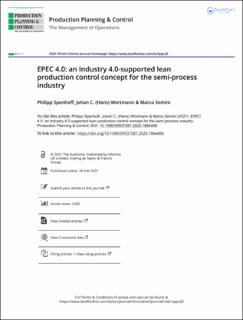| dc.contributor.author | Spenhoff, Philipp | |
| dc.contributor.author | Wortmann, Hans | |
| dc.contributor.author | Semini, Marco | |
| dc.date.accessioned | 2022-06-29T06:45:56Z | |
| dc.date.available | 2022-06-29T06:45:56Z | |
| dc.date.created | 2022-01-19T14:00:12Z | |
| dc.date.issued | 2021 | |
| dc.identifier.citation | Production planning & control (Print). 2021, . | en_US |
| dc.identifier.issn | 0953-7287 | |
| dc.identifier.uri | https://hdl.handle.net/11250/3001425 | |
| dc.description.abstract | The combination of lean production and Industry 4.0 exhibits excellent potential in advancing operations management and, especially, production control. This improvement potential is applicable to the semi-process industry (S-PI), as higher product variety and higher demand variability require greater flexibility from production systems. This flexibility is difficult to achieve in S-PI environments, in which it is imperative to cope with the long setup times and stability needed for the high utilization requirements. Heijunka addresses this stability-flexibility paradox but was designed for short setup times and is thus considered not directly applicable. In this article, we use design science research to adapt Heijunka to the S-PI and combine it with cyber-physical systems technologies. The developed production control concept, every product every cycle (EPEC) 4.0, aims to schedule the production system as efficiently as possible, providing the necessary flexibility and minimum schedule perturbation. Furthermore, we present the findings from a validation case study within the automotive supply industry. | en_US |
| dc.language.iso | eng | en_US |
| dc.publisher | Taylor & Francis | en_US |
| dc.rights | Attribution-NonCommercial-NoDerivatives 4.0 Internasjonal | * |
| dc.rights.uri | http://creativecommons.org/licenses/by-nc-nd/4.0/deed.no | * |
| dc.title | EPEC 4.0: an Industry 4.0-supported lean production control concept for the semi-process industry | en_US |
| dc.type | Peer reviewed | en_US |
| dc.type | Journal article | en_US |
| dc.description.version | publishedVersion | en_US |
| dc.source.pagenumber | 18 | en_US |
| dc.source.journal | Production planning & control (Print) | en_US |
| dc.identifier.doi | 10.1080/09537287.2020.1864496 | |
| dc.identifier.cristin | 1984878 | |
| dc.relation.project | Norges forskningsråd: 174838 | en_US |
| dc.relation.project | Norges forskningsråd: 210577 | en_US |
| cristin.ispublished | true | |
| cristin.fulltext | original | |
| cristin.qualitycode | 1 | |

